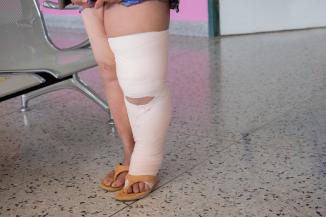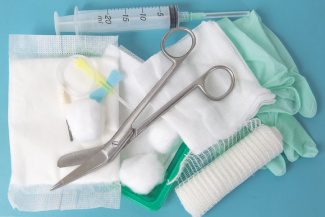Wound Care Commentary: Flora, Symbiosis, and the Microbiome
June 6, 2019
In the United Kingdom, we are well into spring. As I look at the garden, there are patterns of growth literally cut into rock. Old stones with beautiful mosses, and next to a stone step, one type of rock plant has thrown up five stems and atop each is a bright red flower. The path has some wild strawberries growing up through it, and there are two bunches of well-established chives. It is a small plot on the outskirts of Newcastle, and as you walk down the road there are other gardens with similar flowers and weeds.
One plant stands out, though—rosemary. I love this plant and have never had much luck with it. A few of the houses nearby have no front garden and have laid paving of various descriptions in order to park their car. In one such concrete desert, a rosemary plant has pushed its way from a corner and established a bush that is huge and covered in flowers. As I look, my mind is drawn to the apparent chaos and intricacies of nature and how ecosystems interact, copy, mirror, and reflect each other. I say apparent chaos as nature is of course not truly higgledy-piggledy at all, but, like the universe, patterned non-repeatedly toward infinity. This makes me reflect on the nature of wounds, and how we approach treating our patients.
Symbiosis in Wound Care
Why is it, when we are surrounded by such beauty and obvious order, we have such difficulty appreciating similar aspects of our own bodies, fundamental to health? As new student nurses, we learned about the natural flora of the skin and how the microorganisms that live on us protect us. As a newly qualified nurse working in a naturopathic and homoeopathic hospital, I gave yogurt douches and planned meals for patients to attempt to restore their normal microbial balance. I remember thinking disease is like an algae bloom or a voracious weed growing out of control and an antibiotic is not dissimilar to a partially selective digger that unfortunately takes out some of the good with the bad. This is not really analogous at all; it is the way of natural systems.
Whether we work in wound care, where non-healing wounds exemplify broken ecosystems, or with chronic diseases, where such systems are hidden within confounding complexity, it is our job to assist people with teasing out solutions. There has been a big move toward population medicine, and changing direction is impossible, but we need to remember that individuals are not numbers to be added to statistics. They are unique parts of a massive variety that are so similar at times they can be lumped together. We are not only human, we are also symbiotic organisms, and our minuscule friends care not for our consciousness of this universe or our inflated position within it, despite being such an intricate part of us.
The work currently being done on the microbiome is going to make us rethink so many things, from how to lower cesarean section rates and manage those that are performed to radically reducing the use of antibiotic therapy. Vaccination programs are often thought of as the beginning of the modern age of medicine, but it is likely that drastic changes to such programs will herald the new era. Big pharma can either suffer the consequences or become part of the solution. The changes occurring in business practices hold out hope for the latter. The possibility of a new era is of course dependent on whether we actually manage not to extinguish ourselves by eventually actually doing something about the effect we have had on our planet. Living in harmony and balance on our world is essential for the continuation of our species (as the Earth and cockroaches will continue in a heated environment or another Ice Age). Currently we are lemmings heading for the cliff edge (nature's remedy, perhaps). There is sufficient time if those with the power to make changes actually act, instead of plunging their head deeper into the sand where there is profit and the tipping point for humanity gets ever closer.
About the Author
Margaret Heale has a clinical consulting service, Heale Wound Care in Southeastern Vermont and draws on her extensive experience as a wound, ostomy and continence nurse in acute and long-term care settings to provide education and holistic care in her practice.
The views and opinions expressed in this blog are solely those of the author, and do not represent the views of WoundSource, HMP Global, its affiliates, or subsidiary companies.












Follow WoundSource
Tweets by WoundSource